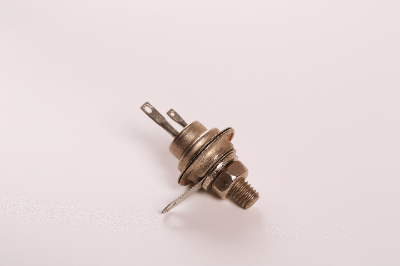What Is a Thyristor?

A thyristor is a semiconductor device with a rectifying action. It is also called an SCR (Silicon Controlled Rectifier). Rectification refers to the conversion of alternating current to direct current. A typical electronic component with a rectifying action is a diode.
The difference between a diode and a thyristor is the gate terminal. The thyristor has a terminal called ‘the gate’. Rectifying action is only shown when current flows through the gate terminal.
Uses of Thyristors
Thyristors are used in industrial applications, such as the soda industry and electrolytic plating. The soda industry is an industry that electrolyzes salt water to produce caustic soda and hydrogen. Caustic soda is used as raw material for soap and detergent. A large DC current for electrolyzing salt water is generated by Thyristors.
In everyday life, thyristors are used for dimming LED lighting by controlling the current to the LEDs.
Principle of Thyristors
The thyristors have a PNPN quadruplex structure consisting of p-type and n-type semiconductors. The gate terminals are drawn out from n or p-type semiconductors in the middle, which are called N-gate and P-gate, respectively.
Since it has a quadruple structure, it has three junctions. Looking at the junctions from the anode side to the cathode side, the first and third junctions are forward-biased. In contrast, the second junction is reverse-biased. In this condition, a tiny current will flow if we pass the current from the anode side to the cathode side.
However, when a forward voltage is applied to the thyristors and current flows to the gate terminal, a phenomenon called avalanche breakdown occurs, and conduction occurs between the anode and cathode. This is called thyristors arc or turn-on.
After the thyristors turn on, conduction is broken when the current flowing to the anode becomes zero. This is called turn-off or quenching. Thyristor turn-off occurs naturally because the alternating current has periodic moments of zero voltage.
Other Information on Thyristors
Thyristors Uses
Thyristors are used in the power section of devices that control large amounts of power. Specific examples are listed below:
1. Rectifier
Rectification means converting alternating current to direct current. Diodes and thyristors are used for rectifiers, which are critical parts of rectifier circuits. Thyristors rectifiers are smaller and lighter than diode rectifiers but generate noise in the power system due to high frequencies. In recent years, rectifiers with transistors have been developed to suppress harmonics.
2. AC Motor Control
The equipment that controls the rotation speed of AC motors is called VVVF equipment, which consists of a converter and an inverter. The converter section converts AC power into DC power. Diodes are mainly used in the converter section.
The inverter section is a device that converts a DC power supply to an AC power supply by the reverse operation of rectification. Inside the inverter, AC power is converted to DC power once. AC current is generated by high-speed switching of the DC power supply with thyristors, etc.